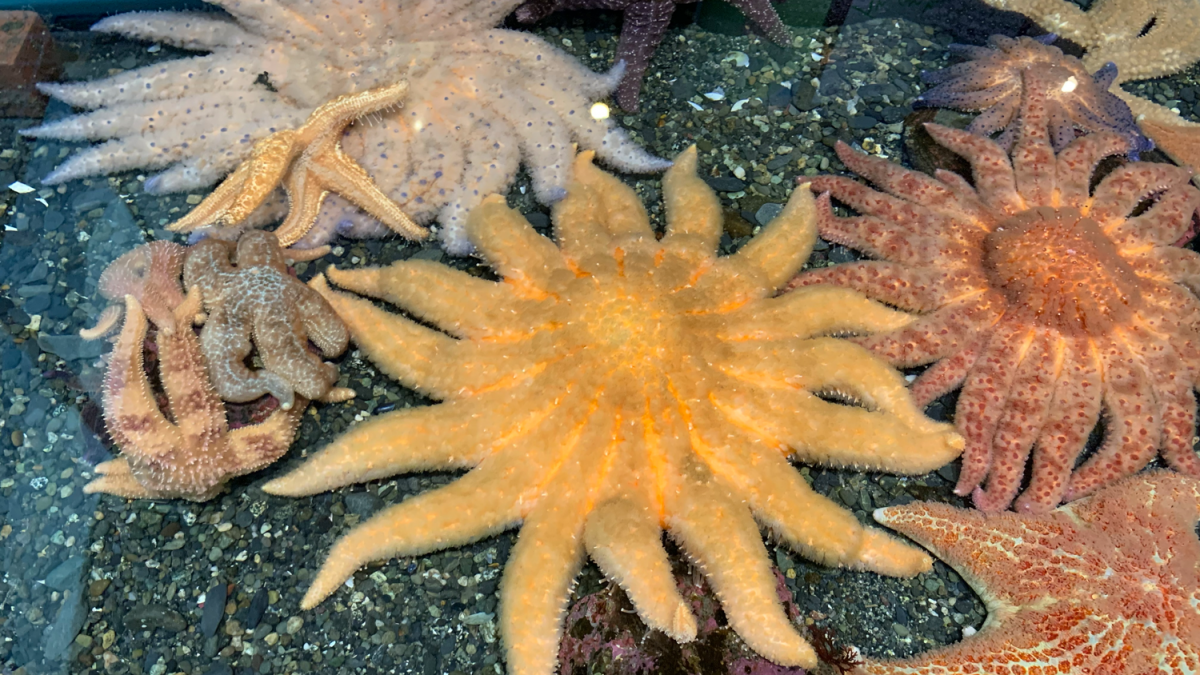Chapter contents:
Echinodermata
–– 1. Exclusively Fossil Taxa
–– 2. Crinoidea
–– 3. Asteroidea ←
–– 4. Ophiuroidea
–– 5. Echinoidea
–– 6. Holothuroidea
You can find 3D models of Asteroidea here.
This page is by Jaleigh Q. Pier and Jansen Smith. It was last updated May 26, 2020.
Above image: A sea star touch tank. Image by: Jonathan R. Hendricks, licensed under a Creative Commons Attribution-Share Alike 4.0 International License.
Class Asteroidea Snapshot
- Examples: sea stars and starfish
- Ecology: marine
- Key features of group: Mobile epifaunal carnivore
- Diversity: ~4,320 living sp., ~1,237 extinct sp.
- Fossil record: Ordovician to Recent
Overview
Members of class Asteroidea are commonly known as sea stars or starfish (though they certainly aren't fish). In Greek, Asteroidea means "star-like" and, as the name suggests, this class has a pentaradial body plan and is composed largely of mobile species. Asteroidea and Ophiuroidea (brittle stars) are sister taxa and together comprise the Asterozoa clade.
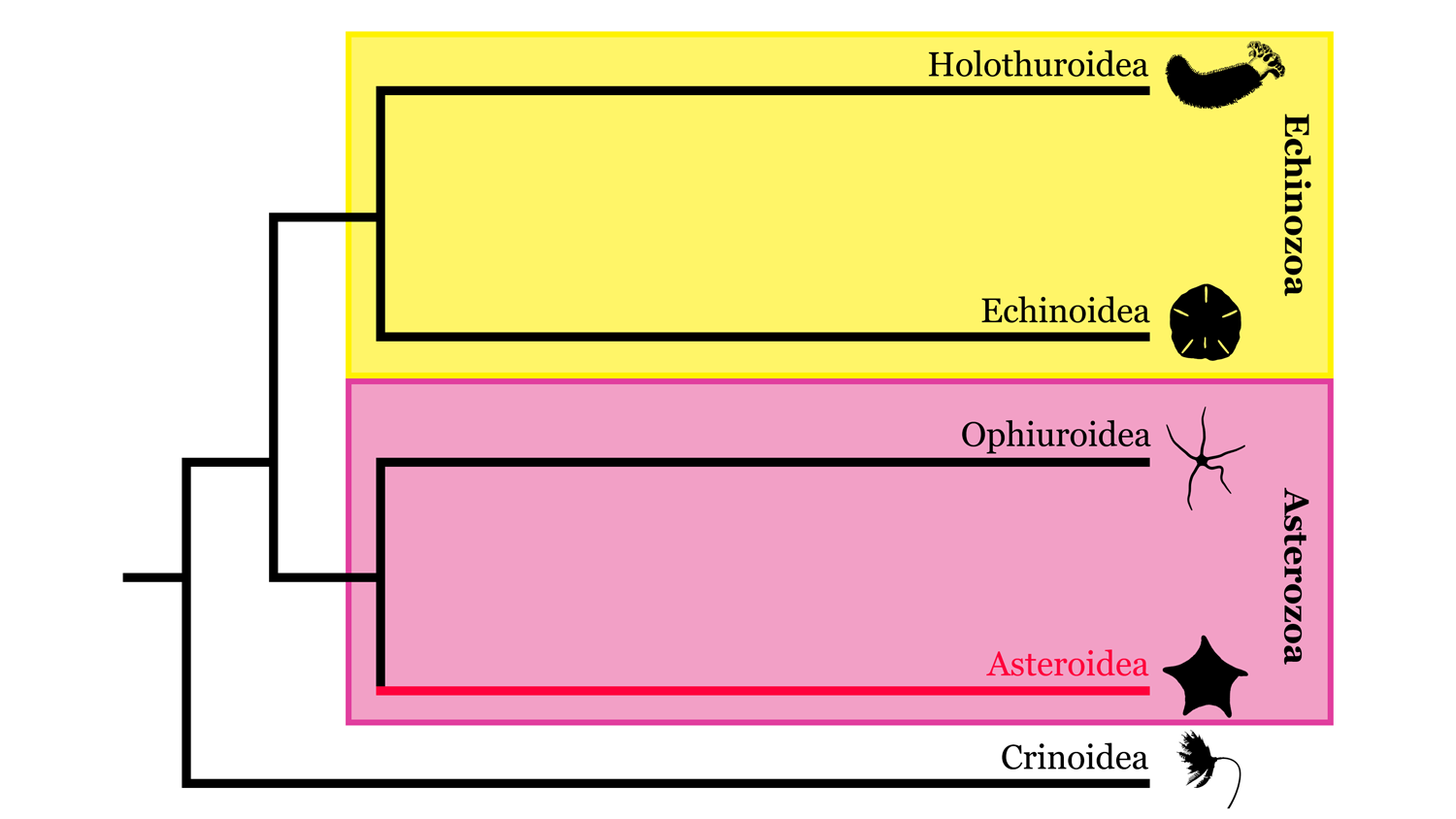
Simplified overview of echinoderm phylogeny based in part on the hypothesis of relationships presented by Reich et al. (2015). Image by: Jaleigh Q. Pier, licensed under a Creative Commons Attribution-Share Alike 4.0 International License.
Sea stars inhabit all our world’s oceans from the tropics to the poles. Living asteroids have been lumped together and called Neoasteroidea because of their differences from Paleozoic forms.
The body of a sea star is made of a central disk with arms radiating outwards, each referred to as a ray. Sea stars commonly have five rays, but some species have far more and these are often in multiples of five, up to fifty or more. Sea stars have an endoskeleton made up of calcareous ossicles, which preserves well if dried out or buried quickly before breaking apart. If you’ve ever held a dried-out sea star, you are holding the internal skeleton, just like the one shown below.
Some of the other terms applied to sea star morphology are labeled on the figure and 3D model below.
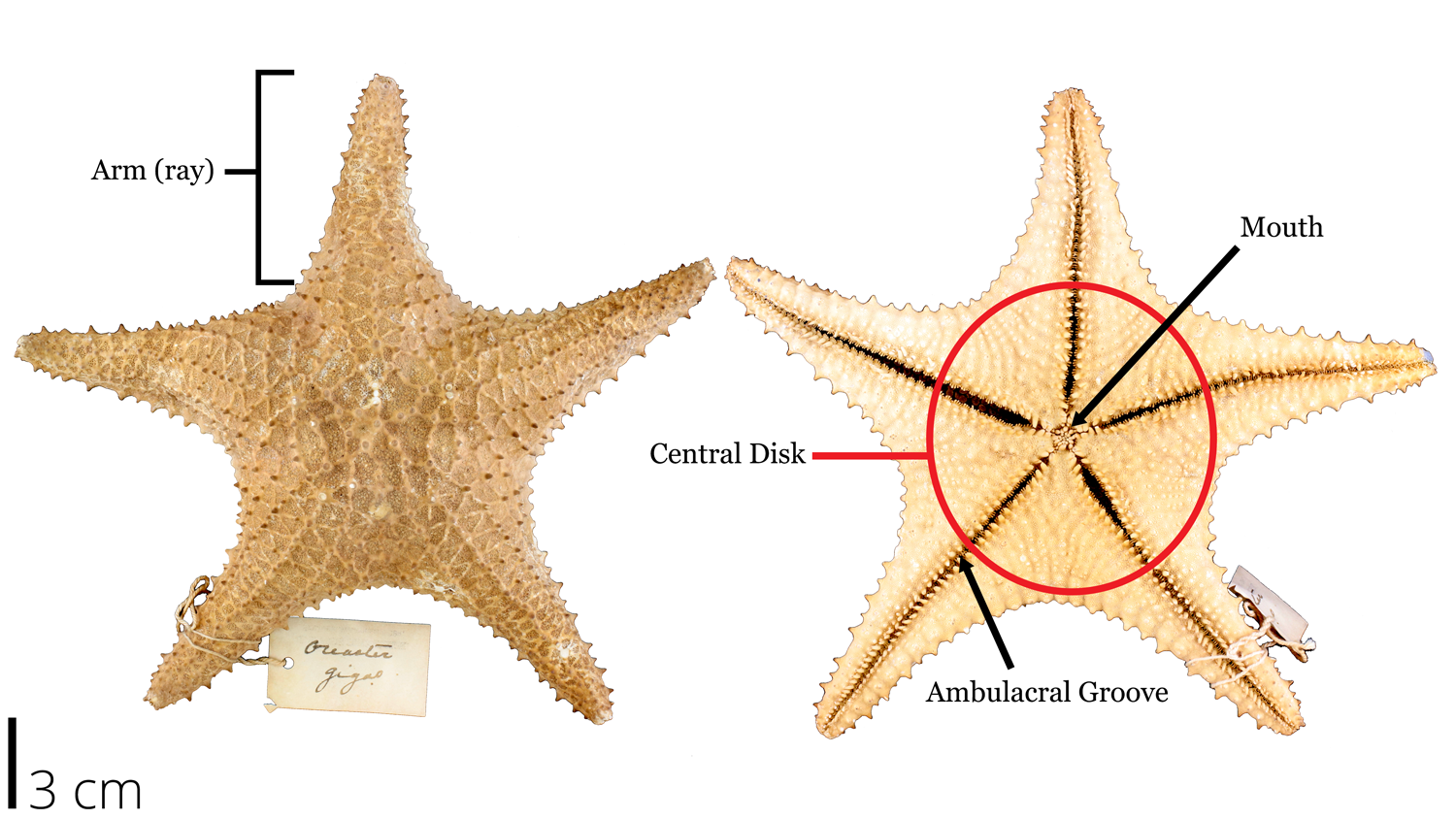
Sea star external morphology. Recent dried sea star specimen from the collections at the Paleontological Research Collection in Ithaca, NY. Image by: Jaleigh Q. Pier, licensed under a Creative Commons Attribution-Share Alike 4.0 International License.
Modern specimen of starfish (or, seastar) (locality information unavailable). Specimen is from the teaching collections of the Paleontological Research Institution, Ithaca, New York. Maximum diameter of specimen is approximately 24 cm.
Water vascular system
Sea stars have a water vascular system that supports its body and helps it move about and feed. Pressure in the water vascular system is controlled through the madreporite. From the madreporite, the system connects to the stone canal, the central canal and then the radial canal of each arm (see diagram below). There, the localized water pressure is controlled by the ampullae, allowing hundreds of tube feet to extend when filled with water and draw back when the ampullae relax their muscles. These suction-cupped feet either pull the sea star along the ocean bottom, or move food particles down the ambulacral groove to the mouth. Ambulacral ossicles can close the ambulacral groove to protect internal organs and tube feet from attacks by predators.
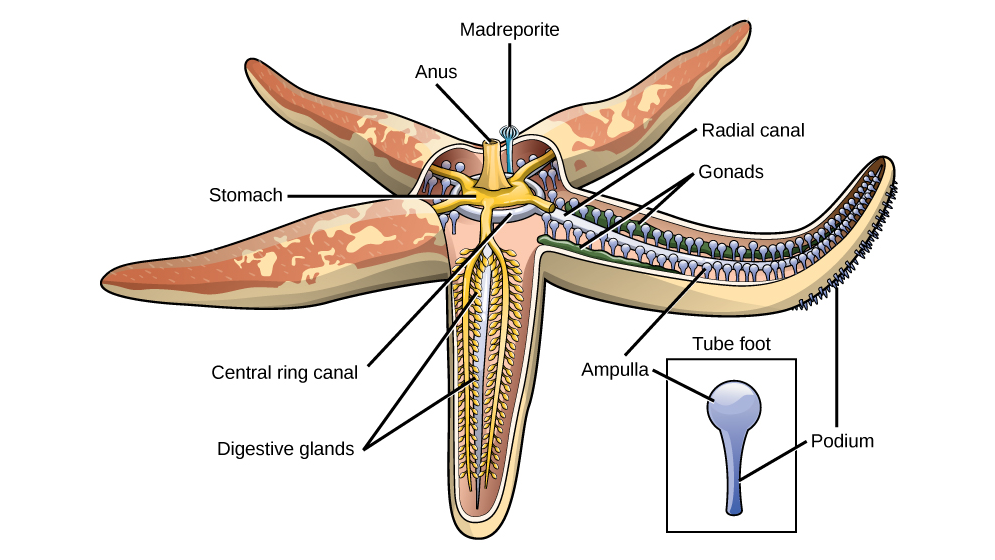
Diagram of sea star internal anatomy. Image by: 'CNX OpenStax' (Wikimedia Commons; Creative Commons Attribution-Share Alike 4.0 International License).
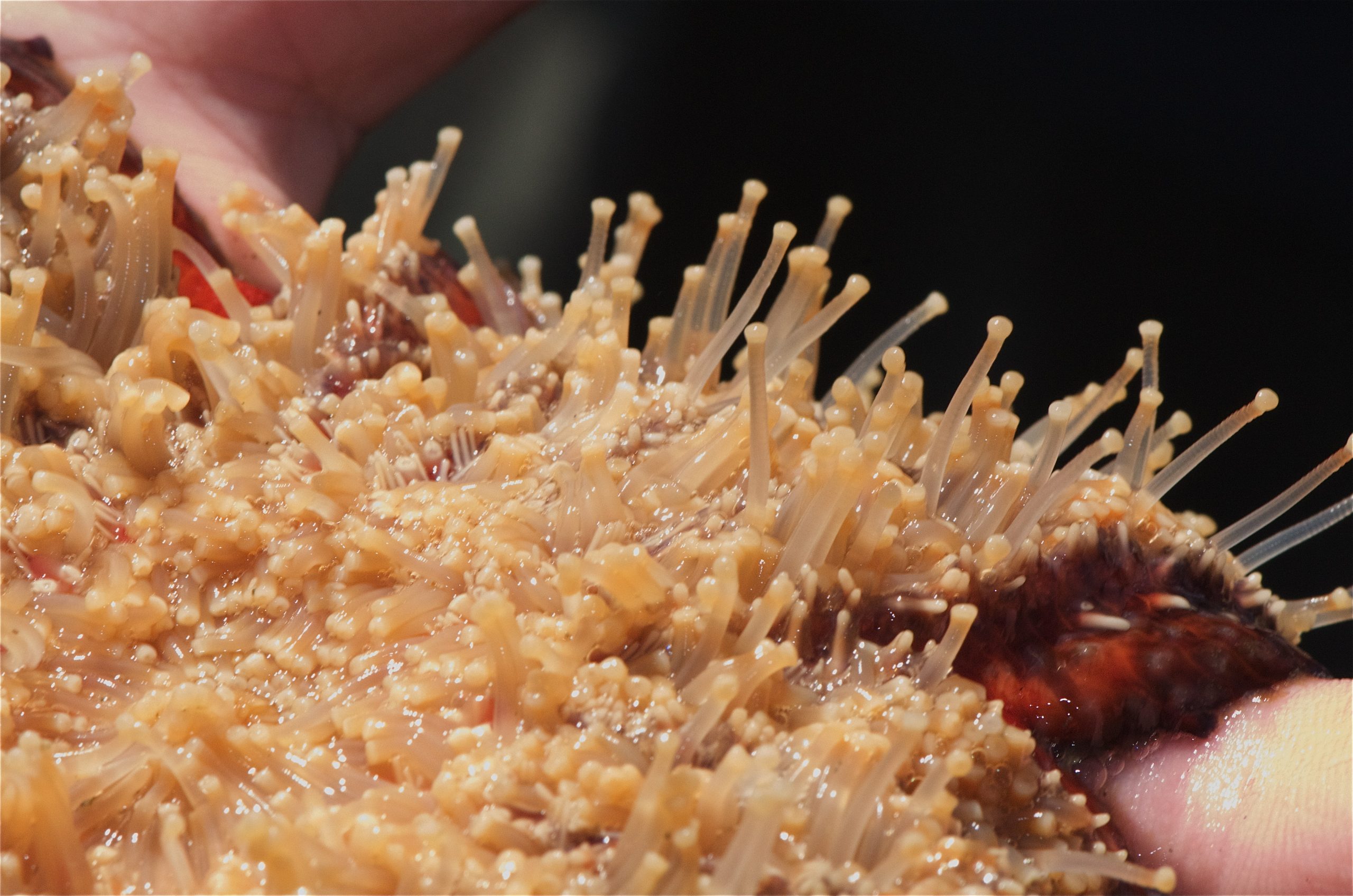
Up-close image of a sea-star's tube feet. Image by: Jerry Kirkhart (Wikimedia Commons; Creative Commons Attribution-ShareAlike 2.0 Generic License).
'Starfish Walking on the Beach' by: Zeb Hallock (YouTube).
Sensory perception
At the end of each arm (or, ray) is an eye spot that can sense changes in light (photoreception). A sea star’s tube feet can also sense or 'taste' chemicals (chemoreception), water currents, and feel objects around them (mechanoreception). Their tube feet are the most sensitive parts of their bodies.
Most sea stars move slowly, but time-lapse videos reveal their paths in fast-forward fashion (see below).
'Are starfish polite? Time lapse footage reveals amazing behavior!' by: Jonathan Bird's Blue World (YouTube).
Sea stars as predators
Sea stars are opportunistic omnivores and terrifying predators, crawling along the ocean bottom with a downward-facing mouth. Most have a one-way digestive system, meaning that food enters and waste exits from the same opening. To feed, they can trap prey or pull apart bivalve shells with their tube feet by maintaining persistent pressure until the bivalve can no longer hold its valves closed. A sea star may be one of the fiercest tug-of-war opponents, being able to maintain such unwavering force for long periods of time. A bivalve only needs to open 0.1 mm for the sea star to protrude its stomach through the gap and into the inside the shell, using digestive enzymes to externally break down its food. Once its prey is digested into a broth-like soup, the sea star slurps it all up to finish digestion inside its body. Watch how this works in the video below!
'Sea-star time-lapse: Eating a mussel' by: Shape of Life (YouTube).
Prey often includes slow moving invertebrates, mainly bivalves and gastropods, however sea stars are also frequent visitors to whale falls and the decaying bodies of other large chordates.
'Sunflower Seastar: Terrifying Predator?' by: National Geographic (YouTube).
Crown of thorns
Some sea stars are regarded as pests. The crown of thorns (COT) sea star is a particular concern in the Pacific Ocean (Kayal et al., 2012). It targets corals as its prey of choice and this has wreaked havoc on many reef ecosystems, including the Great Barrier Reef in Australia. Thankfully, management efforts have been put in place and natural predators are helping to keep the COT population in check. Watch the video below to learn more about the COTs crisis.
'Deadly Starfish Eats Coral: Crown of Thorns Starfish (COTS) crisis' by: The Khaled bin Sultan Living Oceans Foundation (YouTube).
Regeneration and reproduction
Humans have tried in the past to control sea star populations, especially around bivalve fisheries (e.g., mussel beds), by dredging them, chopping them up, and throwing the severed pieces back into the ocean. Unknown to them at the time, sea star pieces that contained part of the ring nerve canal regenerated into hundreds of new sea star individuals, further exacerbating the problem.
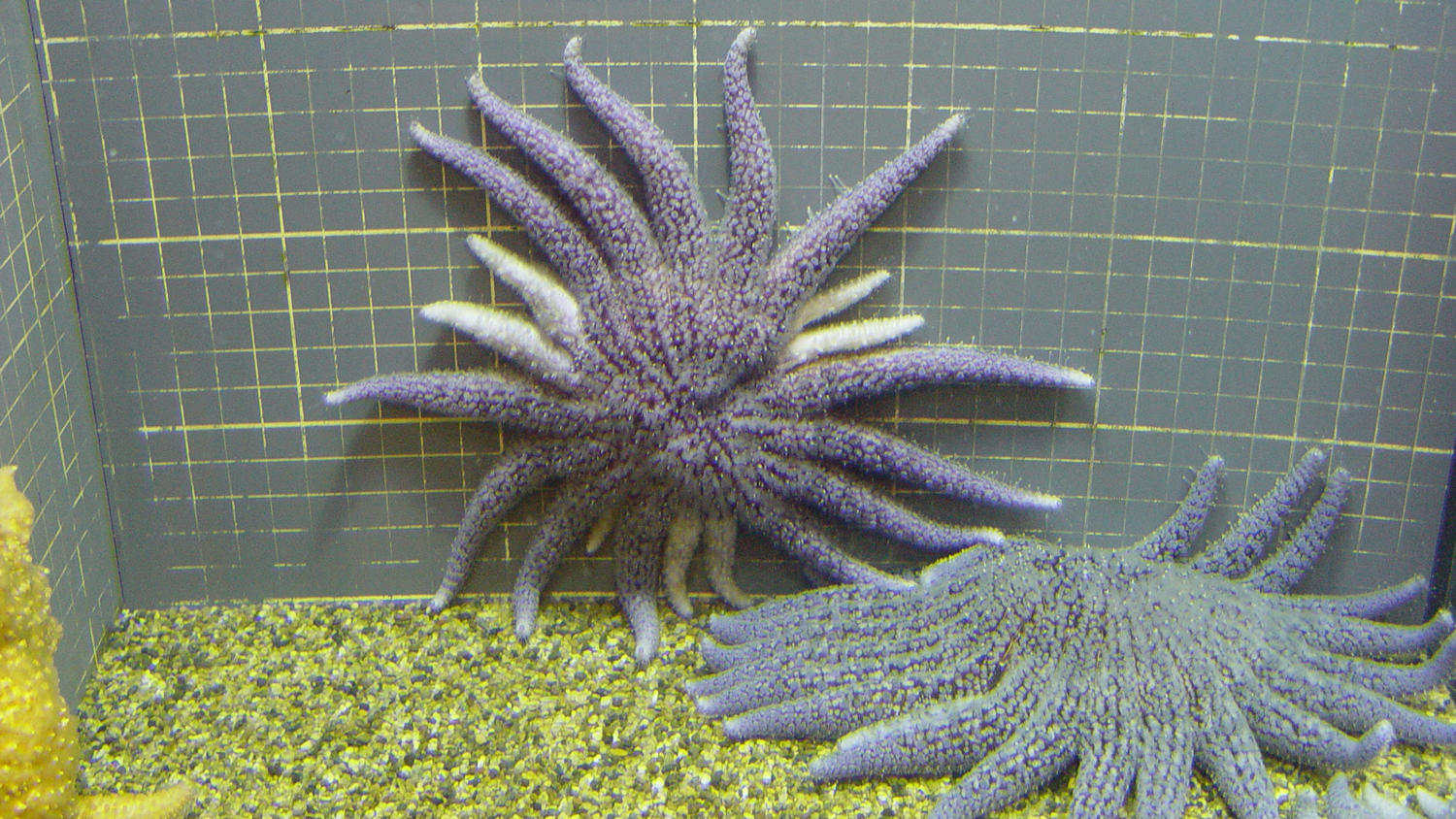
Photograph of a sea star regenerating at least seven arms (smaller, white-colored rays). Image by: Jon R. Hendricks, licensed under a Creative Commons Attribution-Share Alike 4.0 International License.
Similar to sponges, sea stars can reproduce asexually by separating parts from their bodies. The only caveat for most species is that if they lose an arm, that arm will only regrow a new sea star if part of the ring nerve canal was also separated. Otherwise, they can regenerate a new arm or several at the same time. Sea stars also reproduce sexually via spawning (gametes from males and females are released into the water).
Pisaster keystone species
The term "keystone species" was coined for the purple or sometimes orange Pisaster sea star (aka the ochre sea star) by Robert Paine in 1966. A keystone species is necessary to maintain a diverse, healthy ecosystem. Without the keystone species, the ecosystem often falls apart, with only a few species now able to survive.
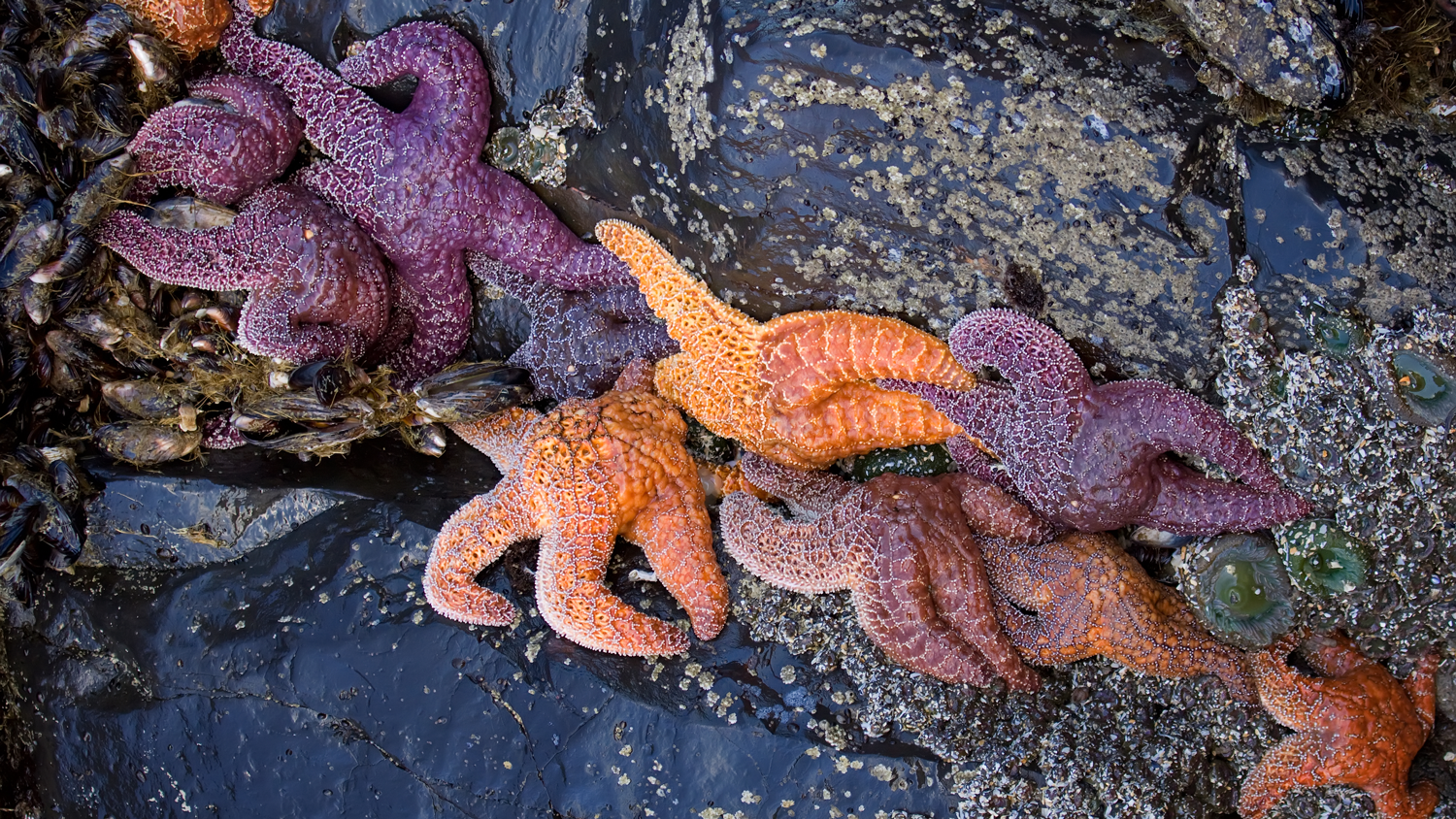
Image of Ochre Sea Star (Pisaster ochraceus) along the Oregon coast, USA. Image by: Steven Pavlov (Wikimedia Commons; Creative Commons Attribution-Share Alike 4.0 International License.)
By comparing tide pools where sea stars were removed and others kept, Paine noticed a change in the ecosystem over time. Tide pools where sea stars were removed had an overabundance of mussels, which out competed everything else for space, resulting in very low ecosystem diversity. However, mussel populations were kept in check when sea stars were present, allowing a much higher diversity of organisms to coexist, thereby maintaining a healthier ecosystem.
'How Starfish Changed Modern Ecology' by: Nature on PBS (YouTube).
In the News: Sea star wasting disease
During the last several years, you may have seen articles on sea stars from the Pacific coast of North America in the news. Unfortunately, several sea star populations, including those that are keystone species, are suffering from a sickness called "sea star wasting disease." Sea stars with this disease disintegrate and fall apart without being able to regenerate limbs like a normal sea star would. Researchers are still trying to figure out how to slow the spread and devastation caused by this disease (Hewson et al., 2014). To learn more about this ‘zombie’ disease, watch the video below!
'Zombie Starfish from Nature's Weirdest Events' by: BBC (YouTube).
Fossil record
The fossil record of asteroids is incomplete and is well characterized by a quote from Mah and Blake (2012, p. 7): “…it is reasonable to interpret the fossil record of all asterozoans as a deeply biased sampling of what once existed.” As discussed by the same authors, this bias and incompleteness is driven by the exposed life mode of asteroids, often on hard substrates; a skeleton composed of unfused elements; and, limitations in the sampling of various environments in the fossil record. Consequently, much remains to be learned about asteroids, particularly those from the Paleozoic.
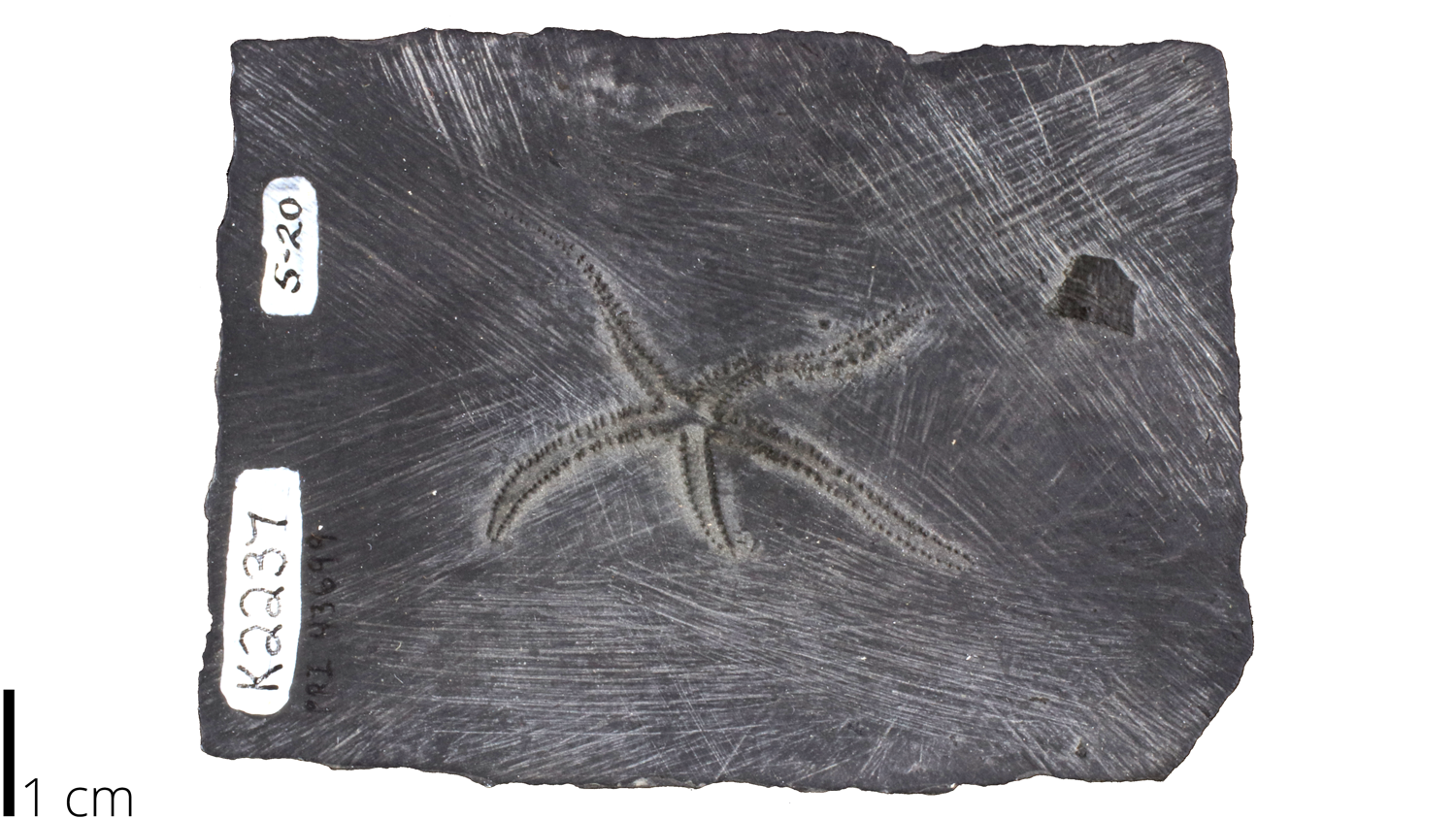
Though they are rare, complete asteroid specimens can been found in environments with exceptional preservation. For example, the fossil Urastella asperula from the Devonian. Specimen from the collections of the Paleontological Research Institution in Ithaca, NY. Image by Jaleigh Q. Pier.
Like the other classes of extant echinoderms, the earliest fossil asteroids are from the Ordovician. Two hypotheses have been proposed in the literature for their origin: (1) evolution from crinoids (learn more about this class on the Crinoid page), and (2) evolution from the Edrioasteroidea (learn more about this class on the Exclusively Fossil Taxa page). Both hypotheses would have required a change in life mode; however, evolution of asteroids from the edioateroids is now considered to be the more likely scenario.
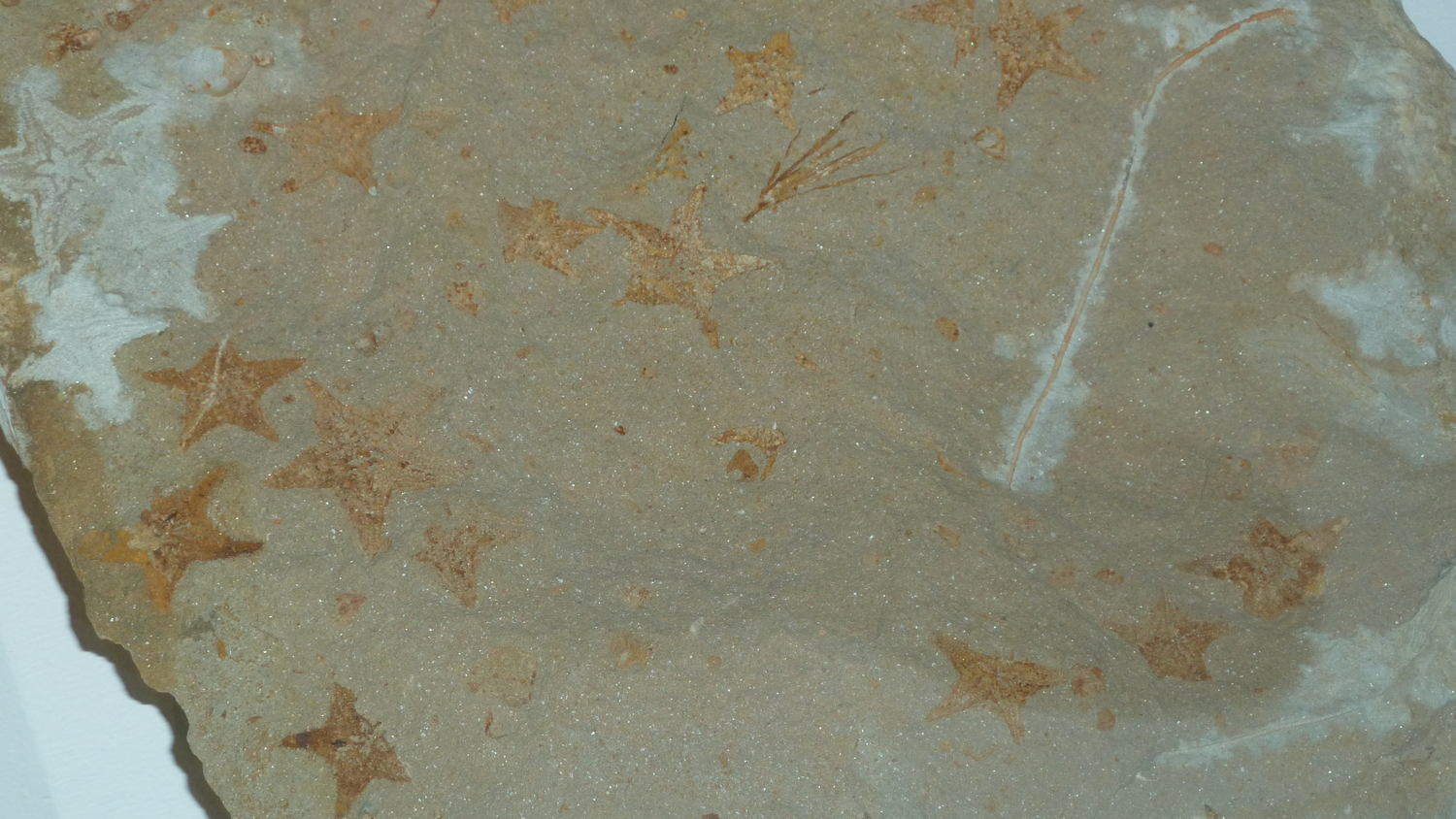
Photograph of a fossil sea star (Salteraster sp) slab from the Silurian. Image by Jon R. Hendricks.
Regardless of whether crinoids, edrioasteroids, or another group gave rise to the asteroids, the asteroids are commonly thought to share this ancestor with the ophiuroids (learn more about this class on the Ophiuroid page), and potentially the fossil group Somasteroidea. Within this group of asterozoans, some have argued that the somasteroids are the primitive ancestor to the other two groups, though again there is not consensus.
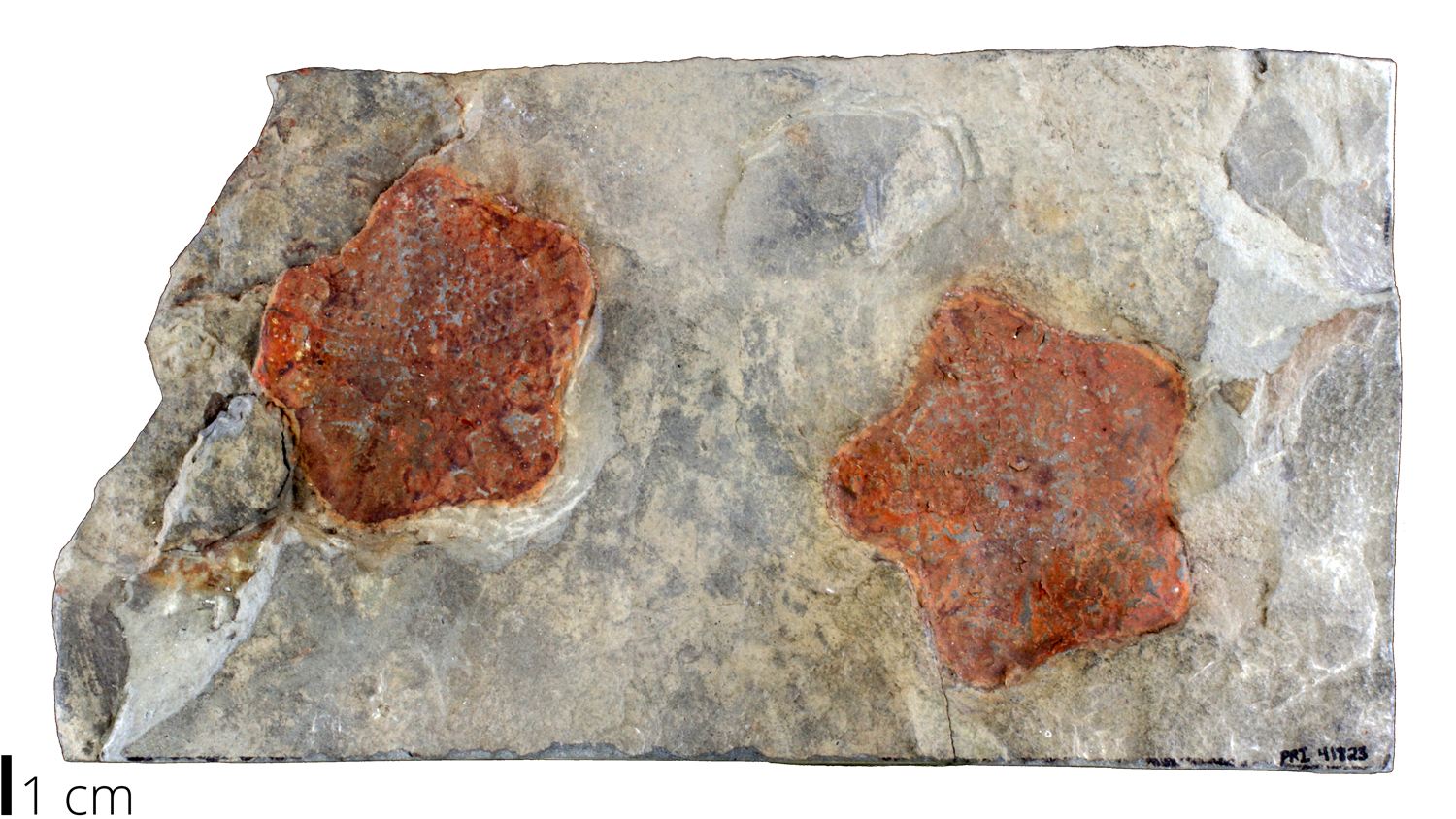
Fossil sea star specimen Hyacticus pentagonus jacksoni (PRI 41823). Specimen from the collections at the Paleontological Research Institution in Ithaca, NY. Image by: Jaleigh Q. Pier, licensed under a Creative Commons Attribution-Share Alike 4.0 International License.
During the Paleozoic, asteroids likely filled a similar range of ecological roles as they do today, though there has been a complete turnover in the genera. What we do know about these early sea stars is based largely on a handful of localities with exceptional preservation, such as the Hunsrück Slate, from the Lower Devonian in Germany, described by Bartels et al. (1998). At this locality, approximately 25 asteroid species have been described—as well as approximately 25 ophiuroid species. These species included a range of forms, including typical five-armed species and species with more than five arms; delicate, thinly skeletonized species and thick, armored species; spiny species; and, species reaching relatively large sizes, even by comparison to modern species. Snapshots like these provide much needed insight on the evolution of this group and suggest that, at least since the Devonian, sea stars have been integral components of ocean bottom communities.
Fossil specimen of the starfish (or, seastar) Urasterella sp. from the Devonian of Tompkins County, New York (PRI 76788). Specimen is from the collections of the Paleontological Research Institution, Ithaca, New York. Longest dimension of rock surrounding specimen is approximately 6.5 cm.
The asteroid fossil record is marked by two major periods of turnover, at the end-Devonian and end-Permian mass extinctions. As with other groups of echinoderms (e.g., crinoids, echinoids), the end-Permian extinction led to a dramatic change in the asteroid fauna. Paleozoic taxa only rarely survived the event and the modern asteroid fauna largely evolved from those few taxa, creating distinct Paleozoic and post-Paleozoic faunas. Starting in the Triassic, and increasingly so during the Jurassic, modern asteroid groups (e.g., Neoasteroidea) became prevalent.
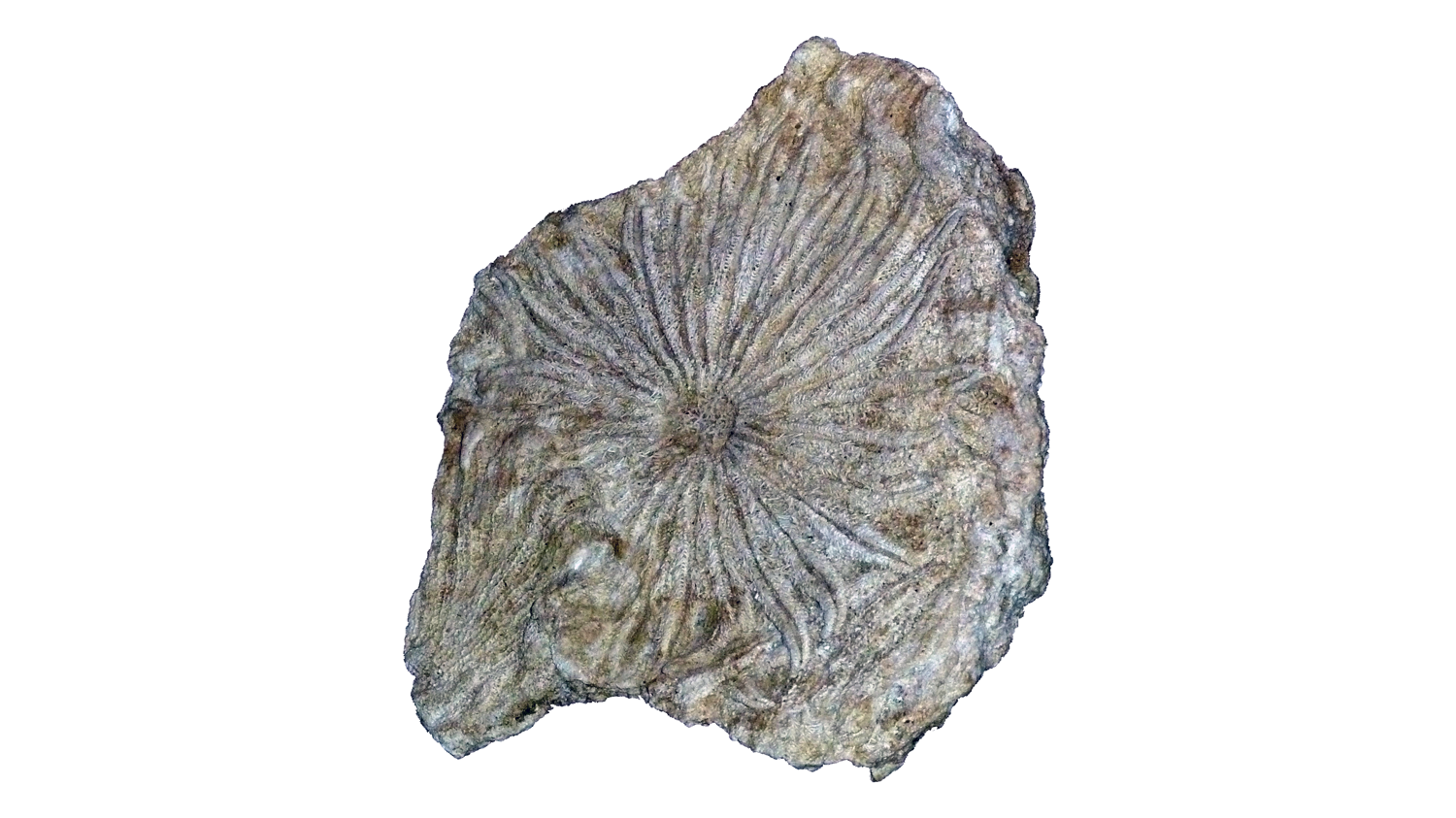
Photograph of a fossil Pliocene sea star (Heliaster microbrachius) from the Florida Museum of Natural History (FMNH). Image by Jon R. Hendricks, licensed under a Creative Commons Attribution-Share Alike 4.0 International License.
Fossil specimens of the starfish (or, seastar) Henricia venturana from the Eocene Cozydell Formation of Ventura County, California (PRI 76786). Specimen from the collections of the Paleontological Research Institution, Ithaca, New York (PRI 76786). Longest dimension of larger starfish is approximately 5 cm
References and further reading:
Daniel B. Blake, The Class Asteroidea (Echinodermata): Fossils and the Base of the Crown Group , Integrative and Comparative Biology, Volume 40, Issue 3, June 2000, Pages 316–325, https://doi.org/10.1093/icb/40.3.316
Boardman, R.S., Cheetham, A.H., and Rowell, A.J. 1987. Fossil Invertebrates. Blackwell Scientific Publications. 713 pp.
Hewson, I. et al. 2014. Densovirus associated with sea-star wasting disease and mass mortality. PNAS, 111(48), p. 17278-17283.
Kayal M, Vercelloni J, Lison de Loma T, Bosserelle P, Chancerelle Y, Geoffroy S, et al. (2012) Predator Crown-of-Thorns Starfish (Acanthaster planci) Outbreak, Mass Mortality of Corals, and Cascading Effects on Reef Fish and Benthic Communities. PLoS ONE 7(10): e47363. https://doi.org/10.1371/journal.pone.0047363
Paine, R.T. 1966. Food web complexity and species diversity. The American Naturalist: 100(910), p. 65-75.
Primus, Alexander E. 2005. Somasteroidea. Version 05 January 2005. http://tolweb.org/Somasteroidea/24272/2005.01.05 in The Tree of Life Web Project, http://tolweb.org/
Mulcrone, R. 2005. "Asteroidea" (On-line), Animal Diversity Web. Accessed December 06, 2019 at https://animaldiversity.org/accounts/Asteroidea/
Mutschke, E. and Mah, C. 2000. Asteroidea. p. 802-830.
Nichols, D., 1967. Echinoderms. Hutchinson University Library, London.
Rahman, M.A. et al. 2018. The Sea Stars (Echinodermata: Asteroidea): Their Biology, Ecology, Evolution and Utilization. Science Forecast, v. 1, p. 1-8.
Reich, A., Dunn, C., Akasaka, K., Wessel, G. (2015) Phylogenomic Analyses of Echinodermata Support the Sister Groups of Asterozoa and Echinozoa. PLoSONE, 10(3): e0119627.
Usage

Unless otherwise indicated, the written and visual content on this page is licensed under a Creative Commons Attribution-NonCommercial-ShareAlike 4.0 International License. This page was written by Jaleigh Q. Pier. See captions of individual images for attributions. See original source material for licenses associated with video and/or 3D model content.



